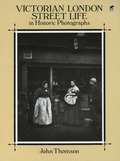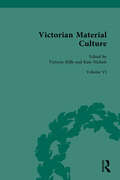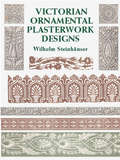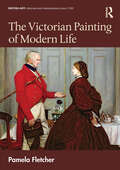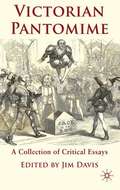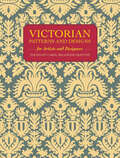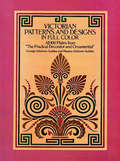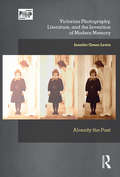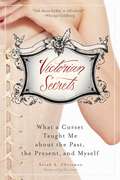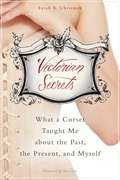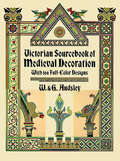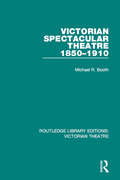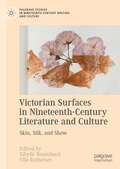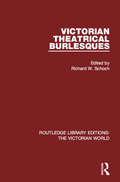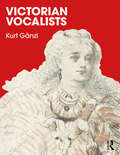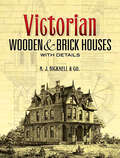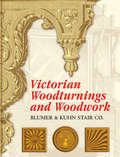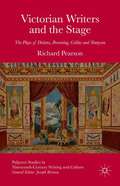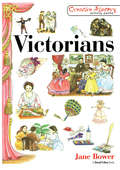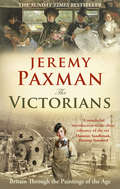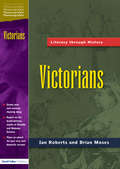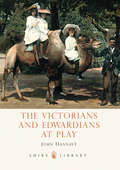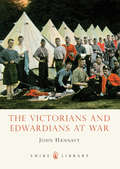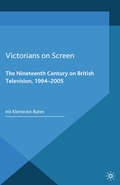- Table View
- List View
Victorian London Street Life in Historic Photographs
by John ThomsonClassic document of social realism contains 37 photographs by famed Victorian photographer John Thomson, accompanied by individual essays -- by Thomson himself or social activist Adolphe Smith -- that offer sharply drawn vignettes of lower-class laborers, dustmen, street musicians, shoe blacks, and other street people. A treasure trove of astonishing historical detail.
Victorian Material Culture
by Tatiana Kontou Victoria Mills Kate NicholsFrom chatelaines to whale blubber, ice making machines to stained glass, this six-volume collection will be of interest to the scholar, student or general reader alike - anyone who has an urge to learn more about Victorian things. The set brings together a range of primary sources on Victorian material culture and discusses the most significant developments in material history from across the nineteenth century. The collection will demonstrate the significance of objects in the everyday lives of the Victorians and addresses important questions about how we classify and categorise nineteenth-century things. This volume on ‘Victorian Arts’ will include sources on painting sculpture, book illustration, photography and the much-neglected area of Victorian stained glass.
The Victorian Novel and the Space of Art
by Dehn GilmoreThis interdisciplinary study argues for the vital importance of visual culture as a force shaping the Victorian novel's formal development and reading history. It shows how authors like Charles Dickens, William Makepeace Thackeray, Wilkie Collins and Thomas Hardy borrowed language and conceptual formations from art world spaces - the art market, the museum, the large-scale exhibition, and art critical discourse - not only when they chose certain subjects or refined certain aspects of realism, but also when they tried to adapt various genres of the novel for a new and newly vociferous mass audience. Quandaries specific to new forms of public display affected authors' sense of their relationship with their own public. Debates about how best to appreciate a new mass of visual information impacted authors' sense of how people read, and consequently the development of particular novel forms like the multi-plot novel, the historical novel, the sensation novel, and fin-de-sicle fiction.
Victorian Ornamental Plasterwork Designs (Dover Pictorial Archive)
by Wilhelm SteinhauserHandsome treasury of more than 320 elegant images for use — royalty-free — by today's artists, illustrators, and anyone interested in the interior decor of bygone days. Includes a wealth of floral and foliated sprays, frames and borders of intricate scrollwork, elaborate wall plaques, ceiling roses, cornices and friezes; and much more.
The Victorian Painting of Modern Life (British Art: Histories and Interpretations since 1700)
by Pamela FletcherThis text offers a comprehensive and tightly focused account of the emergence and flourishing of British modern-life paintings at midcentury. Contemporary subjects were new and risky in the late 1840s and early 1850s; immensely popular and much debated by 1858; and already falling out of fashion by the mid-1860s. The book follows this story chronologically, moving from the anxious attempts by young artists such as William Powell Frith and William Holman Hunt to capture modern life in a visual language that conveyed both the literal and emotional truths of contemporary experience, through the new genre’s explosion into popularity in the later 1850s and early 1860s, and the critical debates (and changing fashions) that led to its diminishment by the end of that decade. The book will be of interest to scholars working in art history, British studies, visual culture, exhibition culture, museum studies, and the sociology of art.
Victorian Pantomime: A Collection of Critical Essays
by Jim DavisFeaturing contributions by new and established nineteenth-century theatre scholars, this collection of critical essays is the first of its kind devoted solely to Victorian pantomime. It takes us through the various manifestations of British pantomime in the Victorian period and its ambivalent relationship with Victorian values.
Victorian Patterns and Designs for Artists and Designers (Dover Pictorial Archive)
by Carol Belanger GraftonOver 150 patterns selected from rare 19th-century publications. Florals, foliates, geometrics, and many other motifs ready to add period flavor to almost any project. Indispensable for textile, package and graphic designers, artists, craftspeople, many more.
Victorian Patterns and Designs in Full Color (Dover Pictorial Archive)
by G. A. AudsleyThe last and one of the most important of the great chromolithographic collections of the Victorian era, this magnificent volume first appeared in 1892. Spans a wide spectrum of ornamental styles: Greek moldings and pilaster designs; medieval roof ornamentation, "masonry" patterns; Renaissance coffer and panel ornamentation; Japanese fret bands; and more.
Victorian Photography, Literature, and the Invention of Modern Memory: Already the Past (Photography, History: History, Photography)
by Jennifer Green-LewisInvented during a period of anxiety about the ability of human memory to cope with the demands of expanding knowledge, photography not only changed the way the Victorians saw the world, but also provided them with a new sense of connection with the past and a developing language with which to describe it. Analysing a broad range of texts by inventors, cultural critics, photographers, and novelists, Victorian Photography, Literature, and the Invention of Modern Memory: Already the Past argues that Victorian photography ultimately defined the concept of memory for generations to come –including our own. In addition to being invaluable for scholars working within the emerging field of research at the intersection of photographic and literary studies, this book will also be of interest to students of Victorian and modernist literature, visual culture and intellectual history.
Victorian Secrets: What a Corset Taught Me about the Past, the Present, and Myself
by Sarah A. ChrismanOn Sarah A. Chrisman's twenty-ninth birthday, her husband, Gabriel, presented her with a corset. The material and the design were breathtakingly beautiful, but her mind immediately filled with unwelcome views. Although she had been in love with the Victorian era all her life, she had specifically asked her husband not to buy her a corset--ever. She'd heard how corsets affected the female body and what they represented, and she wanted none of it. However, Chrisman agreed to try on the garment . . . and found it surprisingly enjoyable. The corset, she realized, was a tool of empowerment--not oppression. After a year of wearing a corset on a daily basis, her waist had gone from thirty-two inches to twenty-two inches, she was experiencing fewer migraines, and her posture improved. She had successfully transformed her body, her dress, and her lifestyle into that of a Victorian woman--and everyone was asking about it. In Victorian Secrets, Chrisman explains how a garment from the past led to a change in not only the way she viewed herself, but also the ways she understood the major differences between the cultures of twenty-first-century and nineteenth-century America. The desire to delve further into the Victorian lifestyle provided Chrisman with new insight into issues of body image and how women, past and present, have seen and continue to see themselves.
Victorian Secrets: What a Corset Taught Me about the Past, the Present, and Myself
by Sarah A. Chrisman Sue LeanOn Sarah A. Chrisman’s twenty-ninth birthday, her husband, Gabriel, presented her with a corset. The material and the design were breathtakingly beautiful, but her mind immediately filled with unwelcome views. Although she had been in love with the Victorian era all her life, she had specifically asked her husband not to buy her a corset?ever. She’d heard how corsets affected the female body and what they represented, and she wanted none of it. However, Chrisman agreed to try on the garment . . . and found it surprisingly enjoyable. The corset, she realized, was a tool of empowerment?not oppression. After a year of wearing a corset on a daily basis, her waist had gone from thirty-two inches to twenty-two inches, she was experiencing fewer migraines, and her posture improved. She had successfully transformed her body, her dress, and her lifestyle into that of a Victorian woman?and everyone was asking about it. In Victorian Secrets, Chrisman explains how a garment from the past led to a change in not only the way she viewed herself, but also the ways she understood the major differences between the cultures of twenty-first-century and nineteenth-century America. The desire to delve further into the Victorian lifestyle provided Chrisman with new insight into issues of body image and how women, past and present, have seen and continue to see themselves.
Victorian Sourcebook of Medieval Decoration: With 166 Full-Color Designs (Dover Pictorial Archive)
by W. Audsley G. AudsleyCompiled by two noted British architects and designers, this magnificent volume was intended to provide Victorian artists and crafters with a rich source of ornamentation adapted from the decoration of medieval buildings.Meticulously reproduced motifs from rare 1882 edition, this volume contains all the original 166 full-color designs as well as the informative introduction and notes on the original plates. Among the designs are elaborate and richly colored diaper patterns, medallions for ornamental devices, pillars and arch moldings, bands and borders, floral and foliated designs, alphabets, illuminated initials, and much more. As in Victorian England, today's artists, designers, and crafters will find these beautiful royalty-free designs ideal for visual inspiration or immediate practical use. Students, art historians, and lovers of fine design will also welcome this collection for its splendid examples of medieval artistry.
Victorian Spectacular Theatre 1850-1910 (Routledge Library Editions: Victorian Theatre #3)
by Michael R. BoothOriginally published in 1981. This study concentrates on one aspect of Victorian theatre production in the second half of the nineteenth century – the spectacular, which came to dominate certain kinds of production during that period. A remarkably consistent style, it was used for a variety of dramatic forms, although surrounded by critical controversy. The book considers the theories and practice of spectacle production as well as the cultural and artistic movements that created the favourable conditions in which spectacle could dominate such large areas of theatre for so many years. It also discusses the growth of spectacle and the taste of the public for it, examining the influence of painting, archaeology, history, and the trend towards realism in stage production. An explanation of the working of spectacle in Shakespeare, pantomime and melodrama is followed by detailed reconstructions of the spectacle productions of Irving’s Faust and Beerbohm Tree’s King Henry VIII.
Victorian Surfaces in Nineteenth-Century Literature and Culture: Skin, Silk, and Show (Palgrave Studies in Nineteenth-Century Writing and Culture)
by Sibylle Baumbach Ulla RatheiserThis volume explores the politics and poetics of Victorian surfaces in their manifold manifestations. In so doing, it examines various cultural products ‘as they are’ and highlights the art of surface composition in the Victorian era as well as the socio-cultural ramifications of the preoccupation with the exterior. By closely reading the various surfaces materialising in Victorian literature and culture, the individual contributions explore the dialectics of surface and depth in Victorian (and Neo-Victorian) cultures as well as the legibility of surfaces. They look into the surfaces of literary narratives, paintings, and film but also into natural surfaces such as skin or bark. Each chapter foregrounds what is present rather than absent in a text, while also paying attention to the surfaces that become manifest on the diegetic level of the text, be they cloth, landscapes, or human bodies or faces.This is an open access book.
Victorian Theatrical Burlesques (Routledge Library Editions: The Victorian World)
by Richard W. SchochFirst published in 2003. Wildly popular in their own day, Victorian burlesques are now little read, scarcely studied, and never performed. Giving long overdue emphasis to an unjustly neglected theatrical tradition, this critical edition - the first to focus on Victorian burlesques of Victorian plays - represents a valuable scholarly tool for students and scholars of modern drama, theatre history, and nineteenth-century popular culture. Victorian Theatrical Burlesques includes a 'state-of-the-art' introduction which provides a general overview of theatrical burlesques in the Victorian era, emphasising performance history. Sustained reference is made to burlesques other than those presented in the anthology. Through its general introduction, prefaces and annotations to individual plays, checklist of burlesque plays, and bibliography, the unique volume allows both specialist and non-specialist readers to see Victorian burlesques as a rich historical record of shifting attitudes toward drama and the theatre.
Victorian Vocalists
by Kurt GanzlVictorian Vocalists is a masterful and entertaining collection of 100 biographies of mid- to late-19th-century singers and stars. Kurt Gänzl paints a vivid picture of the Victorian operatic and concert world, revealing the backgrounds, journeys, successes, failures and misdemeanours of these singers. This volume is not only an outstanding reference work for anyone interested in vocalists of the era, but also a compelling, meticulously researched picture of life in the vast shark tank that was Victorian music.
Victorian Wooden and Brick Houses with Details
by A. J. Bicknell Co.This vintage volume offers a treasure trove of floor plans, elevations, and details of residences and public buildings. Artists, architects, and historians alike will find it an endless source of inspiration.Featured buildings include villas, cottages, and farm houses as well as churches, schools, banks, and many other structures. Eighty-one remarkably detailed illustrations capture the elaborate, distinctive beauty of Victorian-era cornices, staircases, gables, verandas, doors, dormers, and other architectural elements. In addition, a fascinating "Specifications" section highlights construction guidelines for masons, bricklayers, and carpenters.
Victorian Woodturnings and Woodwork (Dover Architecture)
by Blumer Kuhn Stair Co.Reproduced from a rare original, this 1893 catalog offers nearly 800 detailed and authentic illustrations of superior-quality woodturnings and woodwork. In addition to its conventional examples, it features varied and unusual models of the Victorian style, including stairs, stair railings and balusters, and newel posts; mantels; turned porch and veranda work; gables and window hoods; ventilators; rosettes and other wooden ornaments; and moldings and interior finish.An excellent guide for woodturners and cabinetmakers, this volume also provides an inspiring and instructive resource for architects, preservationists, designers, and students of Victoriana.
Victorian Writers and the Stage
by Richard PearsonThis book comprises a study of the plays of Dickens, Browning, Wilkie Collins and Tennyson, alongside the fiction and periodical writings of Thackeray and others. These major Victorian writers authored several professional plays, but why has their achievement been overlooked? Victorian Writers and the Stage brings together comprehensively, for the first time, the professionally performed plays of a group of well-known authors – some of which plays enjoyed long and successful seasons,but all of which have been largely forgotten. The author examines the goal of these writers to become part of an expanding theatrical industry and the problems they encountered in risking their reputations on a literature felt by many to be vulgar and illegitimate. A wealth of new detail carefully positions the plays within the context of the changing Victorian theatre industry and the great battle between the Major and Minor theatres for the future of the modern stage.
Victorians (Creative History Activity Packs Ser.)
by Jane BowerThe innovative Creative History Activity Packs series is designed to help teachers bring history topics to life through imaginative creative arts activities. Each pack includes ten laminated, double-sided cards, printed in full color. Each card describes in detail activities that recreate aspects of life in a particular historical period, using art, drama and dance. Each activity is based on historically researched authentic practices of the time. Ideal for whole class or small group sessions, the packs are an inspiration for busy teachers looking for new ways to approach project work at Key Stage 2 - and are easily applicable for Key Stage 1 classes. Victorian activities in this pack include making decorative objects - penwipers, fans, cornucopias - based on original Victorian patterns; sewing samplers; making miniature gardens; original Victorian parlor games based on both wordplay and physical activity; and an upstairs/downstairs drama.
The Victorians
by Jeremy PaxmanJeremy Paxman's unique portrait of the Victorian age takes readers on an exciting journey through the birth of modern Britain. Using the paintings of the era as a starting point, he tells us stories of urban life, family, faith, industry and empire that helped define the Victorian spirit and imagination.To Paxman, these paintings were the television of their day, and his exploration of Victorian art and society shows how these artists were chronicling a world changing before their eyes. This enthralling history is Paxman at his best - opinionated, informed, witty, surprising - and a glorious reminder of how the Victorians made us who we are today.
Victorians
by Ian Roberts Brian MosesThis book will support children as they: * Write a school report for a Victorian pupil * Compile the biography of a real-life circus performer- "The Human Canon Ball" * Produce a letter to complain about the after-effects of the Victorian remedy carbolic smoke balls!
The Victorians and Edwardians at Play
by John HannavyA picture can say a thousand words and the images caught on camera during the Victorian and Edwardian periods provide a fascinating insight into the lives of Britons during this time. Take a step back between 1840 and 1910 and explore the pastimes, hobbies, sports and other entertainments enjoyed by the Victorians and Edwardians through the rich variety of photographs and vintage postcards in this beautiful album. A world we usually see in monochrome or sepia is presented here in vivid color, bringing the Victorian and Edwardian people a little closer to us. 128 pages are packed with images of people on the golf course, playing croquet and tennis, sports days and football matches. We see visits to the zoo, cruises on river boats and paddle steamers, fairground and pleasure beach excursions, days at the races and other, more unusual pursuits, all of which tell the story of social life 100 to 160 years ago. Go on, take a look!From the Trade Paperback edition.
The Victorians and Edwardians at War
by John HannavyBy the time the first photographs were taken at war in the late 1840s, the idea that 'the camera cannot lie' was already firmly embedded in the Victorian psyche. 'Truthful' in a way the work of the war artist could never be, despite the initially long exposures and cumbersome equipment, cameras have been used to document war ever since the celebrated photographs of Roger Fenton in the Crimea. Through a rich selection of images - many of them never before published - this book tells the story of the photographers who chronicled Britain's Victorian and Edwardian wars and those who fought in them.
Victorians on Screen: The Nineteenth Century on British Television, 1994-2005
by Iris Kleinecke-BatesVictorians on Screen investigates the representation of the Victorian age on British television from the mid-1990s to the mid-2000s. Structured around key areas of enquiry specific to British television, it avoids a narrow focus on genre by instead taking a thematic approach and exploring notions of authenticity, realism and identity.
